Splitting Tensile Strength of Cement Soil Reinforced with Basalt Fibers
Abstract
1. Introduction
2. Materials and Methods
2.1. Materials
2.1.1. Soil
2.1.2. Basalt Fiber
2.1.3. Cement
2.2. Sample Preparation
- (a)
- Air-dry the on-site sampled muddy silty clay first and then pulverizes.
- (b)
- Filter off the impurities by a sieve with an aperture of 2 mm.
- (c)
- Determine the water content of the air-dried muddy silty clay.
- (d)
- Mix basalt fibers with sodium bentonite as a mass ratio of 20:1 first and make sure that the basalt fibers are dispersed fully.
- (e)
- Mix basalt fibers with the air-dried fine muddy silty clay according to the specified mixture design, and stir well to ensure all basalt fibers are dispersed in muddy silty clay evenly. In this study, the homogeneity of fiber distribution in the air-dried fine muddy silty clay was guaranteed by the mixing time, which was determined by trial and error.
- (f)
- Determine the water consumption for the air-dried fine muddy silty clay mixed with basalt fibers based on the water content of the on-site muddy silty clay (36%).
- (g)
- Add the water into the air-dried fine muddy silty clay mixed with basalt fibers, blend fully, and cure for 24 h in a hermetically sealed container to eliminate the impact of clay hydration.
- (h)
- Prepare cement slurry with the water:cement ratio of 0.5, and fill it into the dry fiber-soil mixture at small increments and fully stir.
- (i)
- Remold the samples with sizes of 50 mm in diameter and 100 mm in height, in which the fully mixed fiber-cement-soil mixture is divided into four parts evenly first and then are carefully pouring into the mold in turns. When the soil sample is compacted to the specified height each time, the surface of the soil sample is roughened before pouring another part of the mixture into the mold. The purpose of this treatment is to eliminate the weak contact between adjacent layers.
- (j)
- Removal the mold after standing for 24 h.
- (k)
- Weigh the quantity of the prepared samples, and if the quality of samples has deviated from the mean value by 20%, those samples will be discarded. The main purpose of this step is to eliminate the difference in sample preparation. In this study, each mixing ratio was prepared with six samples at least, but only six samples with the best quality will be selected and further cured under three curing times, including 7 days, 28 days, and 90 days. The relative humidity of standard curing is greater than 95% and the temperature range is 20 ± 3 °C.
- (l)
- Considering that this study pays more attention to saturation strength, the prepared samples were cured in water for 24 h before the expiration of the curing time, and then mechanical testing was carried out.
2.3. Testing Method
2.4. Testing Plan
3. Results and Discussion
3.1. Splitting Tensile Strength and Failure Characteristics
3.2. Influence of Cement Content on Maximum Tensile Strength
3.3. Influence of Curing Time on Maximum Tensile Strength
3.4. Influence of Fiber Content on Maximum Tensile Strength
3.5. Influence of Fiber Length on Maximum Tensile Strength
4. Correlation of Splitting Tensile Strength vs. Compressive Strength
5. Improvement Contribution of Basalt Fibers
5.1. Microstructural Characterization
5.2. Toughening Mechanisms
- (i)
- Strong interfacial bond. The basalt fibers with hydrophilic characteristics and rough furrows at the surface will result in firm contact with the matrix (the cement soil), and this contact will be continuously strengthened by binder development. Meanwhile, an annular region surrounding the basalt fibers will be formed over time by the dual action of fiber and matrix, thereby further enhancing this interfacial bond. Once this interfacial bond is strong enough to limit the subsequent shrinkage, the trapped matrix between the fibers will be confined, leading to a higher load-bearing capacity. This strong interfacial bond will also cause tensile stress in failure zones transformed into shear stress at the fiber-matrix interface and resisted through the adhesion and friction at their contact surfaces when the cement soil reinforced with basalt fibers is subjected to an external load.
- (ii)
- Effective bridging effect. In general, increasing the basalt fiber content and consequently enhancing the bridging effect can improve the integrity of cement soil effectively, and alleviate the internal concentrated stresses applied in different orientations by transferring them into a uniform distribution. This mechanism implies that a large number of fibers bridging over an extended length can significantly contribute to the amount of energy absorption of the soil-cement-fiber composites. Besides, although increasing the fiber content will also result in poor compaction, and the formation of many microcracks instead of a few large macrocracks, the cracks are initiating locally where the applied stress is higher than the tensile strength of the matrix. Once a crack faces fibers, those bridging fibers will sustain and transfer stresses by the deformation of the fibers itself and the friction between the fibers and the matrix. The bridging effect at a crack will be lost when the bridging fibers are pulled out or broken. This, however, will demand much higher external work, and result in the formation of multiple microcracks and pseudo strain hardening.
- (iii)
- Crack deflection and branching effect. When a crack reaches to fibers, the fibers may debond due to insufficient fiber length or interfacial bond. The interaction of propagating micro-cracks and the position of the other fibers may result in the crack deflecting or branching in-plane. In particular, when the fibers with higher Young’s modulus are used, the crack-propagation behaviors such as deflection and branching will prevent the tendency of crack localization along a certain path, and thus increase the effectual crack path to cause energy absorption and enhance the toughness.
6. Conclusions
- (1)
- The key to making cement soil samples is to distribute the basalt fibers into the cement soil evenly. The best way to solve the difficulties in engineering mixing and facilitate ongoing fieldwork and quality control is to mix the muddy silty clay with basalt fibers first, then with cement slurry.
- (2)
- The improvement of cement content on the strength of soil mass can be replaced by basalt fiber’s reinforcement effect. However, the greater basalt fiber content and longer basalt fiber length do not always lead to a better reinforcement effect for the cement soil. The ideal reinforcement effect of basalt fiber for the cement muddy silty clay will be achieved when the basalt fiber content and length are 0.4% and 12 mm.
- (3)
- The strong linear relationships between the splitting tensile strength and the compressive strength of the cement soil with or without fiber inclusion were achieved with high determination coefficients. The cement soil reinforced with basalt fiber has a better correlation of the splitting tensile strength and the compressive strength, and a better improvement in splitting tensile strength with the correlation coefficient of 0.245.
- (4)
- The contribution of basalt fibers on the toughening mechanisms of cement soil can be explained by fiber–matrix interaction, including strong interfacial bonds, an effective bridging effect, crack deflection and branching effects, etc., which are also responsible for the improvement of overall mechanical properties of the soil-cement-fiber composites. The results of this study can provide a parameter basis for the application and popularization of cement soil in engineering.
Author Contributions
Funding
Acknowledgments
Conflicts of Interest
References
- Jiang, G.L.; Chen, S.L.; Mao, X.W.; Hou, R.; Shi, A.Q. Experimental Study on Splitting Tensile Strength of Cement Soil. J. Highw. Transp. Res. Dev. 2017, 34, 29–33. [Google Scholar]
- Peng, H.M.; Li, A.T.; Yang, R.; Li, H. Research on Confecting the Mixed-Mud in Underground Continuous Wall. Hans J. Civ. Eng. 2013, 2, 32–36. [Google Scholar] [CrossRef]
- Consoli, N.C.; Prietto, P.D.M.; Ulbrich, L.A. Influence of Fiber and Cement Addition on Behavior of Sandy Soil. J. Geotech. Geoenvironmental Eng. 1998, 124, 1211–1214. [Google Scholar] [CrossRef]
- Consoli, N.C.; Zortéa, F.; De Souza, M.; Festugato, L. Studies on the Dosage of Fiber-Reinforced Cemented Soils. J. Mater. Civ. Eng. 2011, 23, 1624–1632. [Google Scholar] [CrossRef]
- Festugato, L.; Menger, E.; Benezra, F.; Kipper, E.A.; Consoli, N.C. Fiber-Reinforced Cemented Soils Compressive and Tensile Strength Assessment as a Function of Filament Length. Geotext. Geomembr. 2017, 45, 77–82. [Google Scholar] [CrossRef]
- Aflaki, E.; Sedighi, P.; Eslami, A. Study on the Failure Behavior of Three Different Stabilized Problematic Soils. Trans. Civ. Eng. 2014, 21, 1231–1240. [Google Scholar]
- Crockford, W.W.; Little, D.N. Tensile Fracture and Fatigue of Cement-Stabilized Soil. J. Transp. Eng. 1987, 113, 520–537. [Google Scholar] [CrossRef]
- Wang, W.J. Study on Reinforcement Mechanism and Damage Performance of Cemented Soil Stabilized with Nanometer Material; Zhejiang University: Haining, China, 2004. [Google Scholar]
- Huang, Y.; Zhou, Z.Z.; Bai, W.; Chen, Q.F. Micro-Experiments on a Soft Ground Improved by Cement-Mixed Soils with Gypsum Additive. Chin. J. Geotech. Eng. 2010, 32, 1179–1183. [Google Scholar]
- Sim, J.; Park, C.; Moon, D.Y. Characteristics of basalt fiber as a strengthening material for concrete structures. Compos. Part B Eng. 2005, 36, 504–512. [Google Scholar] [CrossRef]
- Borhan, T.M. Properties of Glass Concrete Reinforced with Short Basalt Fiber. Mater. Des. 2012, 42, 265–271. [Google Scholar] [CrossRef]
- Zhang, D.; Xu, Q.; Guo, Y. Experiments on Strength and Shrinkage of Expansive Soil with Basalt Fiber Reinforcement. J. Southeast Univ. (Nat. Sci. Ed.) 2012, 42, 975–980. [Google Scholar]
- Gao, L.; Hu, G.; Xu, N.; Fu, J.; Xiang, C.; Yang, C. Experimental Study on Unconfined Compressive Strength of Basalt Fiber Reinforced Clay Soil. Adv. Mater. Sci. Eng. 2015, 2015, 1–8. [Google Scholar] [CrossRef]
- Gao, L.; Hu, G.H.; Chen, Y.H.; Hu, Y.J.; Gong, Y.H. Triaxial Tests Clay Reinforced by Basalt Fiber. Chin. J. Geotech. Eng. 2017, 39, 198–203. [Google Scholar]
- Zhuang, X.S.; Yu, X.Y. Experimental Study on Strength Characteristics of Lime - Basalt Fiber Reinforced Expansive Soil. Appl. Mech. Mater. 2015, 744, 495–498. [Google Scholar] [CrossRef]
- Liu, Q.; Shaw, M.T.; Parnas, R.S.; McDonnell, A.-M. Investigation of basalt fiber composite aging behavior for applications in transportation. Polym. Compos. 2006, 27, 475–483. [Google Scholar] [CrossRef]
- Dhand, V.; Mittal, G.; Rhee, K.Y.; Park, S.-J.; Hui, D. A short review on basalt fiber reinforced polymer composites. Compos. Part B Eng. 2015, 73, 166–180. [Google Scholar] [CrossRef]
- Jalasutram, S.; Sahoo, D.R.; Matsagar, V. Experimental Investigation of the Mechanical Properties of Basalt Fiber Reinforced Concrete. Struct. Concr. 2017, 18, 292–302. [Google Scholar] [CrossRef]
- Sylovanyuk, V.P.; Yukhym, R.Y.; Lisnichuk, А.E.; Ivantyshyn, N.А. Computational Model of the Tensile Strength of Fiber-Reinforced Concrete. Mater. Sci. 2015, 51, 340–347. [Google Scholar] [CrossRef]
- Rill, E.; Lowry, D.R.; Kriven, W.M. Properties of basalt fiber reinforced geopolymer composites. In Proceedings of the 34th International Conference on Advanced Ceramics and Composites, Daytona Beach, FL, USA, 24–29 January 2010; Volume 31, pp. 57–67. [Google Scholar]
- Ranjbar, N.; Zhang, M. Fiber Reinforced Geopolymer Composites: A Review. Cem. Concr. Compos. 2019, 2019, 103498. [Google Scholar] [CrossRef]
- Chou, J.-S.; Ngo, N.-T. Engineering strength of fiber-reinforced soil estimated by swarm intelligence optimized regression system. Neural Comput. Appl. 2016, 30, 2129–2144. [Google Scholar] [CrossRef]
- Orakoglu, M.E.; Liu, J. Effect of freeze-thaw cycles on triaxial strength properties of fiber-reinforced clayey soil. KSCE J. Civ. Eng. 2017, 6, 284–2140. [Google Scholar] [CrossRef]
- Wang, M.C.; Zhang, Z.G.; Li, Y.B.; Li, M.; Sun, Z. Chemical Durability and Mechanical Properties of Alkali-Proof Basalt Fiber and Its Reinforced Epoxy Composites. J. Reinf. Plast. Compos. 2008, 27, 393–407. [Google Scholar] [CrossRef]
- Wu, G.; Wang, X.; Wu, Z.; Dong, Z.; Zhang, G. Durability of basalt fibers and composites in corrosive environments. J. Compos. Mater. 2014, 49, 873–887. [Google Scholar] [CrossRef]
- Li, M.; Gong, F.; Wu, Z. Study on mechanical properties of alkali-resistant basalt fiber reinforced concrete. Constr. Build. Mater. 2020, 245, 118424. [Google Scholar] [CrossRef]
- Lee, J.J.; Song, J.; Kim, H. Chemical stability of basalt fiber in alkaline solution. Fibers Polym. 2014, 15, 2329–2334. [Google Scholar] [CrossRef]
- Hu, X.X. Basalt Fiber Alkali Resistance and Concrete Properties; Yangzhou University: Yangzhou, China, 2017. [Google Scholar]
- Zhang, P.; Yang, H.W.; Li, J.C. Basalt Fiber Reinforced Cement-Soil Mixing Pile and Its Construction Method. CN105970946A, 28 September 2016. [Google Scholar]
- Feng, Z.C.; Zhu, W. Influence of Clay Content on Mechanical Properties of Solidified Silt. J. Rock Mech. Eng. 2007, 26, 3052–3057. [Google Scholar]
- Industrial Standard of the People’s Republic of China. Specification for Mix Proportion Design of Cement Soil (JGJ/T 233-2011); China Building Industry Press: Beijing, China, 2011. [Google Scholar]
- Tran, K.Q.; Satomi, T.; Takahashi, H. Tensile behaviors of natural fiber and cement reinforced soil subjected to direct tensile test. J. Build. Eng. 2019, 24, 100748. [Google Scholar] [CrossRef]
- Tran, K.Q.; Satomi, T.; Takahashi, H. Improvement of mechanical behavior of cemented soil reinforced with waste cornsilk fibers. Constr. Build. Mater. 2018, 178, 204–210. [Google Scholar] [CrossRef]
- Cristelo, N.; Cunha, V.M.C.F.; Gomes, A.T.; Araújo, N.; Miranda, T.; de Lurdes Lopes, M. Influence of Fiber Reinforcement on the Post-cracking Behavior of a Cement Stabilized Sandy-clay Subjected to Indirect Tensile Stress. Constr. Build. Mater. 2017, 138, 163–173. [Google Scholar] [CrossRef]
- Srivastava, S.; Rao, A.K.; Zain, M.; Kumar, R. Utilization of waste rubber fiber considering modification in strength reduction factor and its effect on the behavior of concrete. Mater. Today Proc. 2020, 21, 1489–1495. [Google Scholar] [CrossRef]
- Hu, J.L.; Yang, X.; Cui, N.F.; Zhang, Y.D.; Zhang, S.J.; Liang, L.Y. Effects of Basalt Fiber on Mechanical Properties of Cement Soil. J. Water Resour. Archit. Eng. 2017, 15, 138–142. [Google Scholar]
- Wang, D.; Ju, Y.; Shen, H.; Xu, L. Mechanical properties of high performance concrete reinforced with basalt fiber and polypropylene fiber. Constr. Build. Mater. 2019, 197, 464–473. [Google Scholar] [CrossRef]
- Subramaniaprasad, C.K.; Abraham, B.M.; Nambiar, E.K.K. Influence of Embedded Waste-Plastic Fibers on the Improvement of the Tensile Strength of Stabilized Mud Masonry Blocks. J. Mater. Civ. Eng. 2015, 27, 04014203. [Google Scholar] [CrossRef]
- Feng, H.; Chen, G.; Gao, D.; Zhao, K.; Zhang, C. Mechanical Properties of Steel Fiber-Reinforced Magnesium Phosphate Cement Mortar. Adv. Civ. Eng. 2018, 2018, 1–11. [Google Scholar] [CrossRef]
- Deng, Y.S.; Wu, P.; Zhao, M.H.; Duan, B.-Z. Strength of Expansive Soil Reinforced by Polypropylene Fiber under Optimal Water Content. Rock Soil Mech. 2017, 38, 349–353. [Google Scholar]
- Ghourchian, S.; Wyrzykowski, M.; Lura, P. A practical approach for reducing the risk of plastic shrinkage cracking of concrete. Rilem Tech. Lett. 2017, 2, 40–44. [Google Scholar] [CrossRef]
- Zhao, P.; Zsáki, A.M.; Nokken, M. Using digital image correlation to evaluate plastic shrinkage cracking in cement-based materials. Constr. Build. Mater. 2018, 182, 108–117. [Google Scholar] [CrossRef]
- Wei, L.; Chai, S.X.; Zhang, H.Y.; Shi, Q. Mechanical properties of soil reinforced with both lime and four kinds of fiber. Constr. Build. Mater. 2018, 172, 300–308. [Google Scholar] [CrossRef]
- Ranjbar, N.; Talebian, S.; Mehrali, M.; Kuenzel, C.; Metselaar, H.S.C.; Jumaat, M.Z. Mechanisms of interfacial bond in steel and polypropylene fiber reinforced geopolymer composites. Compos. Sci. Technol. 2016, 122, 73–81. [Google Scholar] [CrossRef]
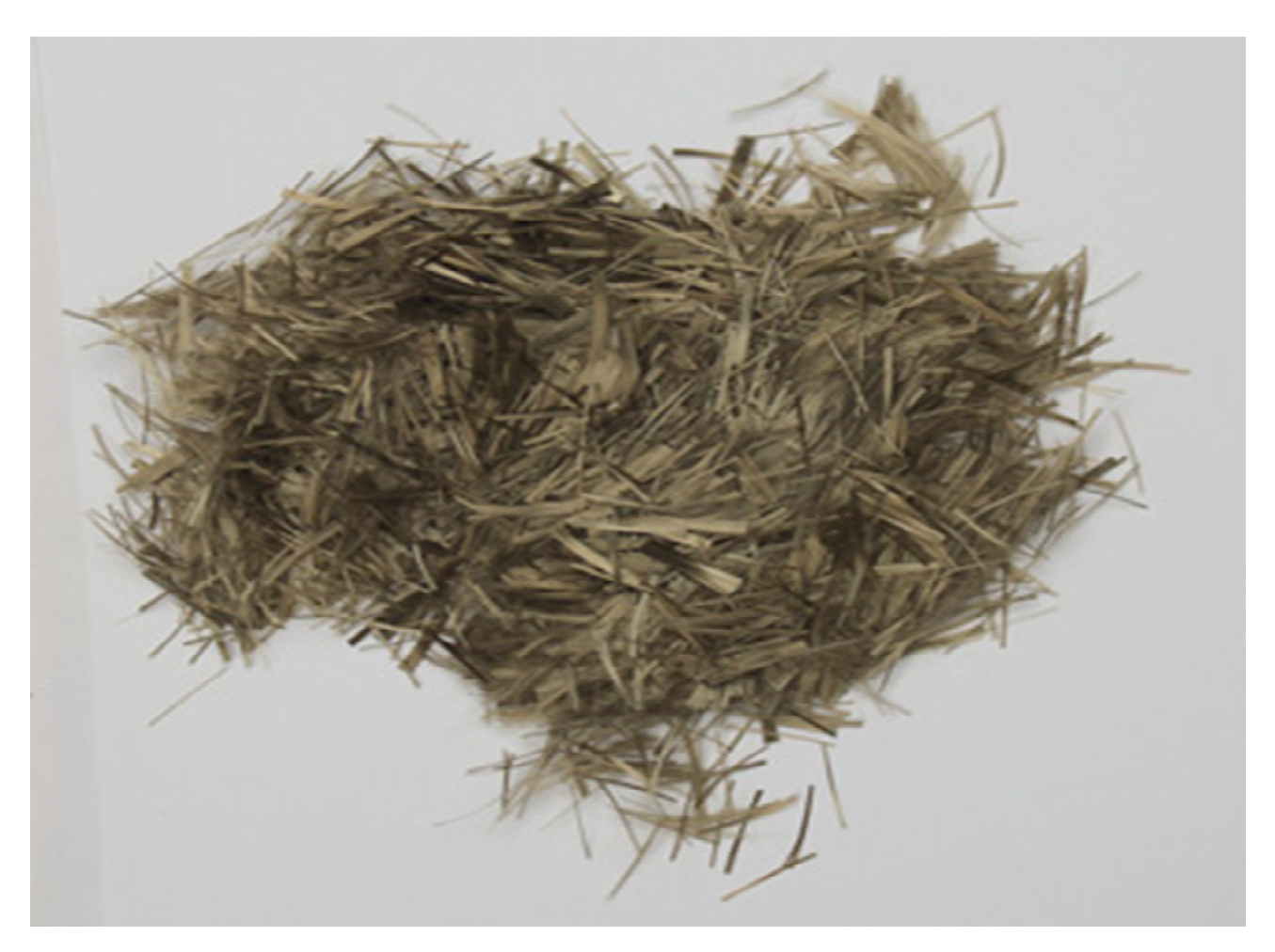
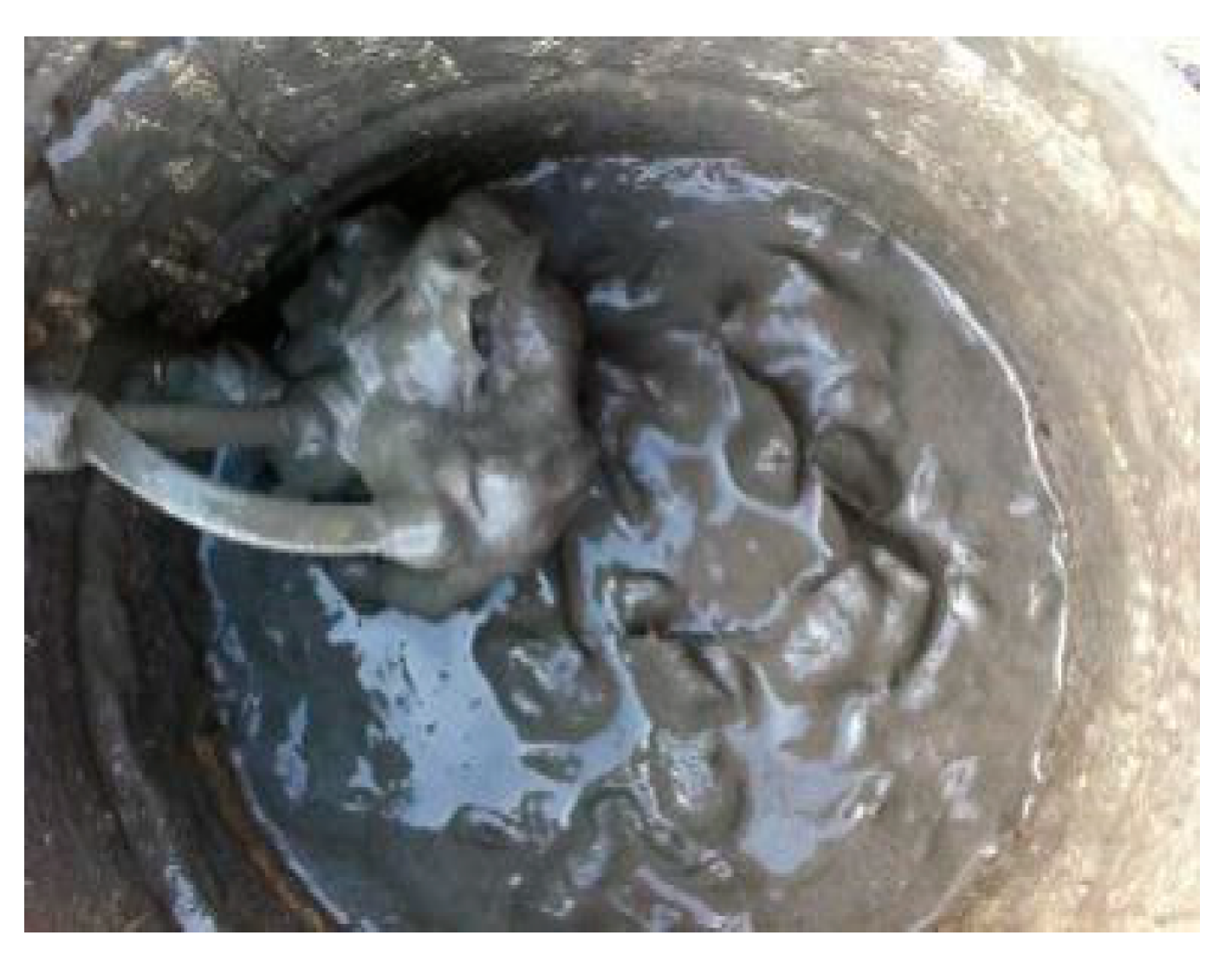

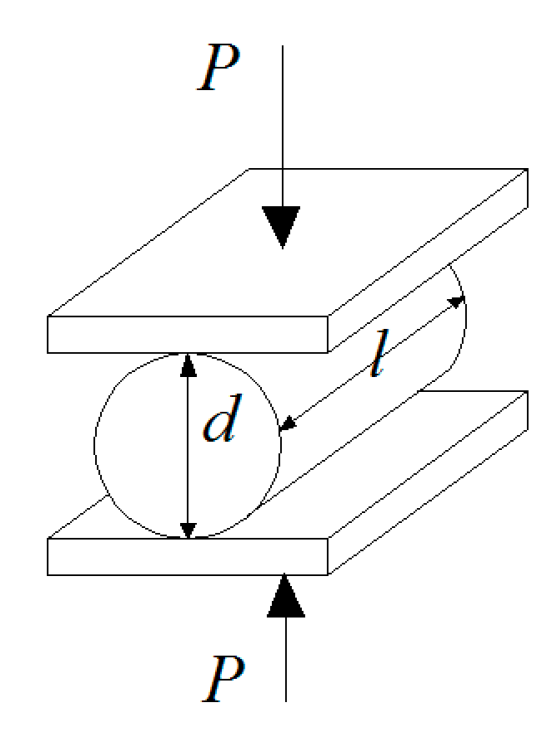
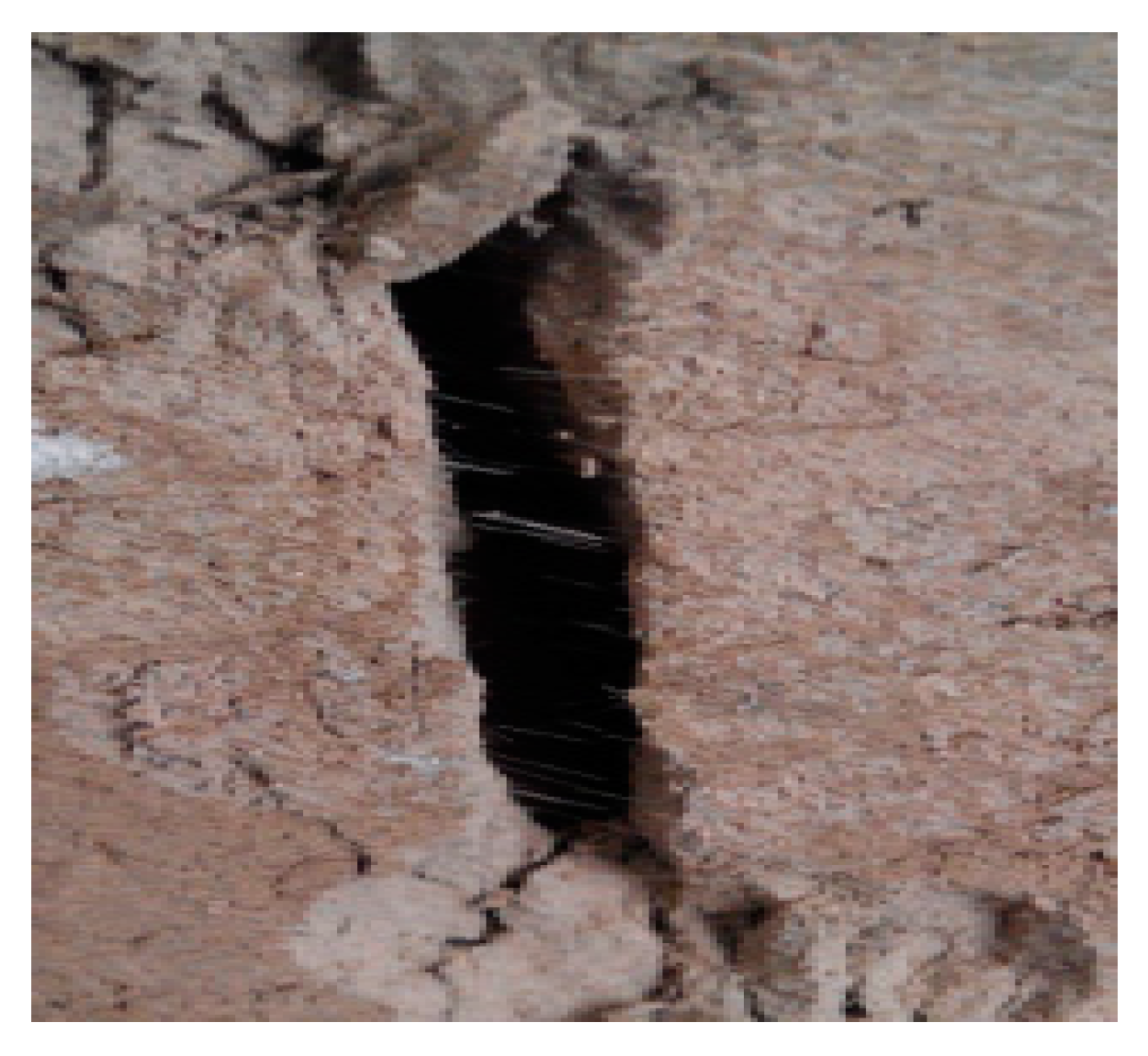


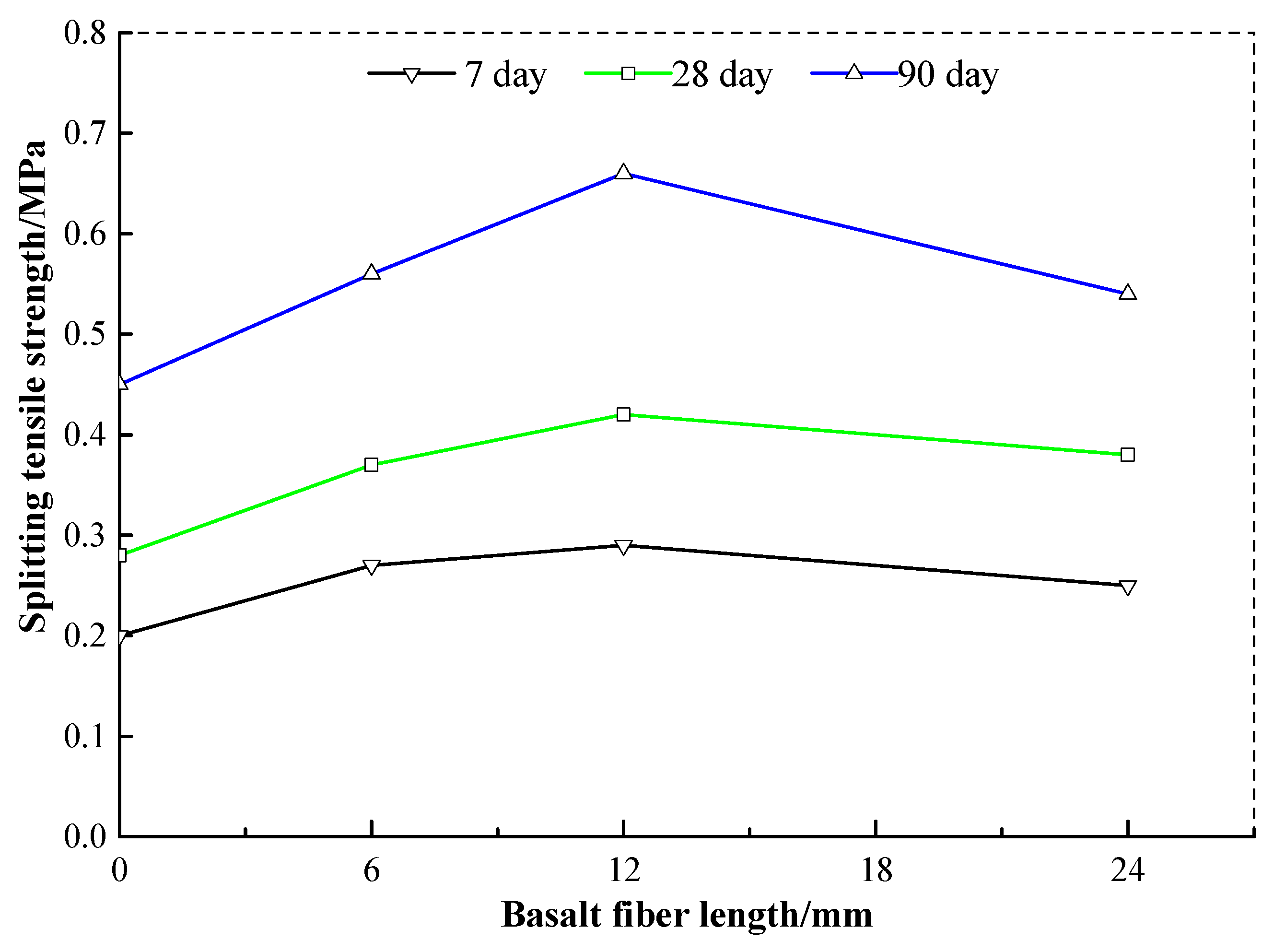
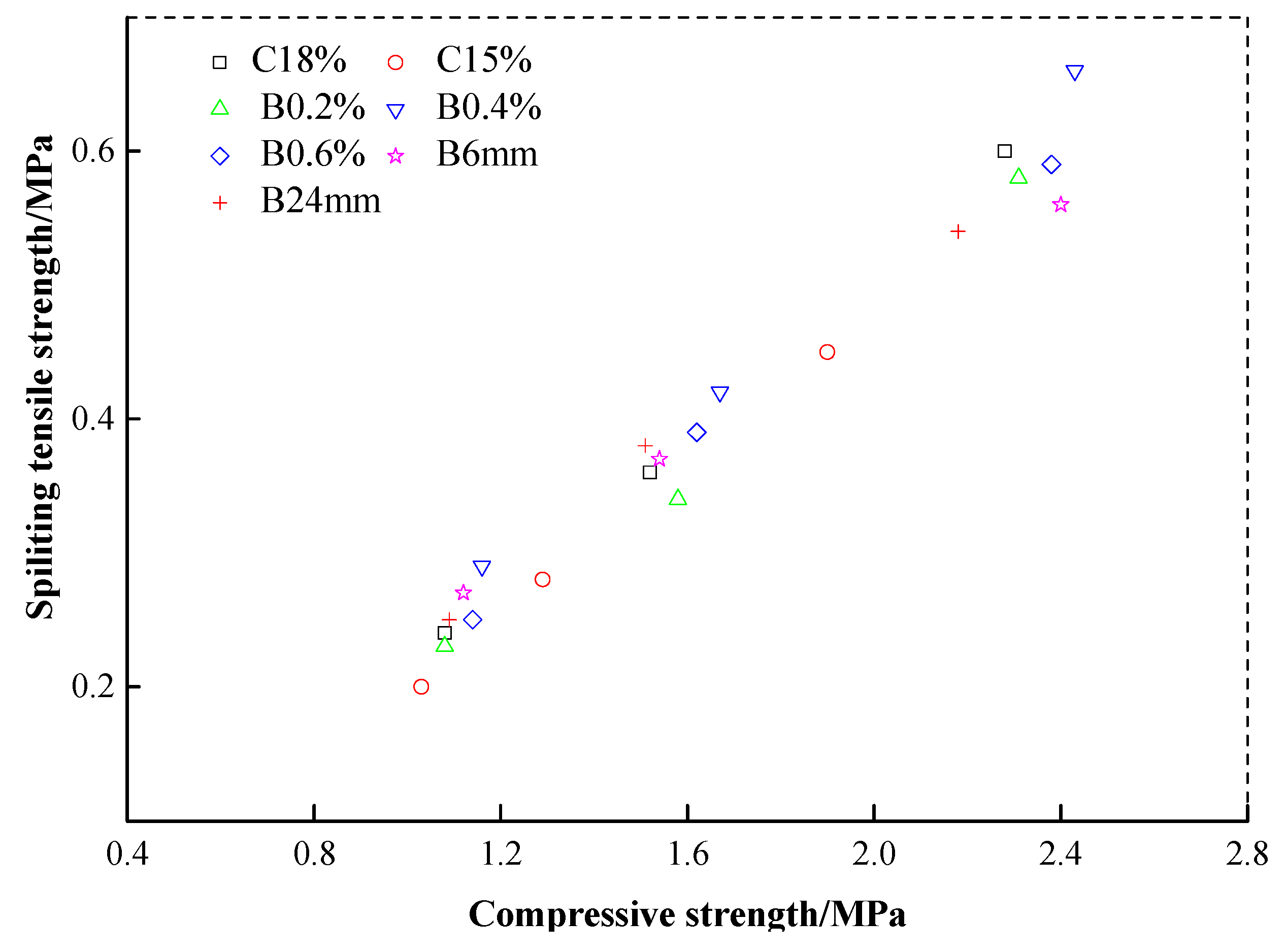

| Physical and Mechanical Index | Value | Physical and Mechanical Index | Value | |
|---|---|---|---|---|
| Natural water content (%) | 36.2 | Plastic limit (%) | - | 22.9 |
| Natural density (g/cm3) | 1.8 | Plasticity index | - | 10.9 |
| Void ratio | 1.014 | Particle size distribution (%) | 0.250–0.075 mm | 3.7 |
| Saturation degree (%) | 96.0 | 0.075–0.005 mm | 85.5 | |
| Liquid limit (%) | 33.8 | <0.005 mm | 10.8 | |
| Specific gravity | 2.69 | Type of soil | - | Muddy silty clay |
| Performance Parameters | Value | Performance Parameters | Value |
|---|---|---|---|
| Raw material ingredient | Basalt fiber | Fiber type | Monofilament bundle |
| Monofilament diameter (µm) | 13 | Density (k/cm3) | 2.65 |
| Tensile strength (MPa) | ≥2000 | Elastic Modulus (GPa) | 90~110 |
| Ultimate elongation (%) | 3.5 | Acid and alkali resistance (%) | ≥99 |
| Melting point(°C) | 1250 | - | - |
| No. | Cement Content/% | Fiber Content/% | Fiber Length/mm | Number of Samples | ||
|---|---|---|---|---|---|---|
| 7 Days | 28 Days | 90 Days | ||||
| C18% | 18 | 0 | 0 | 6 | 6 | 6 |
| C15% | 15 | 0 | 0 | 6 | 6 | 6 |
| B0.2% | 15 | 0.2 | 12 | 6 | 6 | 6 |
| B0.4% | 15 | 0.4 | 12 | 6 | 6 | 6 |
| B0.6% | 15 | 0.6 | 12 | 6 | 6 | 6 |
| B6 mm | 15 | 0.4 | 6 | 6 | 6 | 6 |
| B24 mm | 15 | 0.4 | 24 | 6 | 6 | 6 |
| No. | 7 Days/MPa | Cv | 28 Days/MPa | Cv | 90 Days/MPa | Cv |
|---|---|---|---|---|---|---|
| C18% | 0.24 | 0.03 | 0.36 | 0.03 | 0.60 | 0.08 |
| C15% | 0.20 | 0.01 | 0.28 | 0.03 | 0.45 | 0.05 |
| B0.2% | 0.23 | 0.01 | 0.34 | 0.09 | 0.58 | 0.01 |
| B0.4% | 0.29 | 0.04 | 0.42 | 0.08 | 0.66 | 0.05 |
| B0.6% | 0.25 | 0.07 | 0.39 | 0.02 | 0.59 | 0.03 |
| B6 mm | 0.27 | 0.02 | 0.37 | 0.01 | 0.56 | 0.05 |
| B12 mm | 0.29 | 0.04 | 0.42 | 0.08 | 0.66 | 0.05 |
| B24 mm | 0.25 | 0.08 | 0.38 | 0.05 | 0.54 | 0.07 |
| Curing Time/Day | Growth Rate Compared with Plain Cement Soil (C15%)/% | ||
|---|---|---|---|
| B0.2% | B0.4% | B0.6% | |
| 7 | 15.5 | 45.0 | 25.0 |
| 28 | 21.4 | 50.0 | 39.3 |
| 90 | 28.9 | 46.7 | 31.1 |
| Curing Time/Day | Growth Rate Compared with Plain Cement Soil (C15%)/% | ||
|---|---|---|---|
| B6 mm | B12 mm | B24 mm | |
| 7 | 35.0 | 45.0 | 25.0 |
| 28 | 32.1 | 50.0 | 35.7 |
| 90 | 24.4 | 46.7 | 20.0 |
| No. | 7 Days/MPa | Cv | 28 Days/MPa | Cv | 90 Days/MPa | Cv |
|---|---|---|---|---|---|---|
| C18% | 1.08 | 0.01 | 1.52 | 0.04 | 2.28 | 0.07 |
| C15% | 1.03 | 0.03 | 1.29 | 0.05 | 1.90 | 0.02 |
| B0.2% | 1.08 | 0.04 | 1.58 | 0.09 | 2.31 | 0.01 |
| B0.4% | 1.16 | 0.03 | 1.67 | 0.03 | 2.43 | 0.07 |
| B0.6% | 1.14 | 0.01 | 1.62 | 0.01 | 2.38 | 0.01 |
| B6 mm | 1.12 | 0.08 | 1.54 | 0.03 | 2.40 | 0.04 |
| B12 mm | 1.16 | 0.03 | 1.67 | 0.03 | 2.43 | 0.07 |
| B24 mm | 1.09 | 0.01 | 1.51 | 0.07 | 2.18 | 0.07 |
| No. | Cement Content/% | Fiber Content/% | Fiber Length/mm | Correlation Coefficient, a | Determination Coefficient, R2 |
|---|---|---|---|---|---|
| C18% | 18 | 0 | 0 | 0.256 | 0.980 |
| C15% | 15 | 0 | 0 | 0.224 | 0.984 |
| B0.2% | 15 | 0.2 | 12 | 0.247 | 0.990 |
| B0.4% | 15 | 0.4 | 12 | 0.263 | 0.994 |
| B0.6% | 15 | 0.6 | 12 | 0.242 | 0.996 |
| B6 mm | 15 | 0.4 | 6 | 0.236 | 0.998 |
| B24 mm | 15 | 0.4 | 24 | 0.246 | 0.996 |
© 2020 by the authors. Licensee MDPI, Basel, Switzerland. This article is an open access article distributed under the terms and conditions of the Creative Commons Attribution (CC BY) license (http://creativecommons.org/licenses/by/4.0/).
Share and Cite
Wang, S.; Chen, F.; Xue, Q.; Zhang, P. Splitting Tensile Strength of Cement Soil Reinforced with Basalt Fibers. Materials 2020, 13, 3110. https://doi.org/10.3390/ma13143110
Wang S, Chen F, Xue Q, Zhang P. Splitting Tensile Strength of Cement Soil Reinforced with Basalt Fibers. Materials. 2020; 13(14):3110. https://doi.org/10.3390/ma13143110
Chicago/Turabian StyleWang, Shengnian, Fangyuan Chen, Qinpei Xue, and Peng Zhang. 2020. "Splitting Tensile Strength of Cement Soil Reinforced with Basalt Fibers" Materials 13, no. 14: 3110. https://doi.org/10.3390/ma13143110
APA StyleWang, S., Chen, F., Xue, Q., & Zhang, P. (2020). Splitting Tensile Strength of Cement Soil Reinforced with Basalt Fibers. Materials, 13(14), 3110. https://doi.org/10.3390/ma13143110





